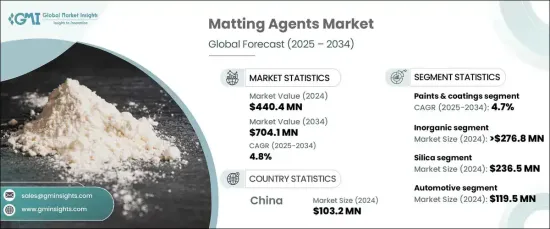
세계의 소광제 시장은 2024년에 4억 4,040만 달러에 달했고, 2025년부터 2034년에 걸쳐 4.8%의 연평균 복합 성장률(CAGR)로 안정적으로 성장할 것으로 예측되고 있습니다.
소광제는 페인트, 코팅제 및 잉크에 사용되는 중요한 첨가제로 광택 수준을 낮추고 매트 마감을 만듭니다. 매트는 일반적으로 빛을 산란시키는 미세하게 깨진 입자로 구성되어 부드럽고 반사가 없는 표면을 제공합니다. 매트 마감 수요가 다양한 산업에서 계속 증가하고 있기 때문에 소광제 시장은 큰 성장을 이루고 있습니다. 이 급성장의 배경은 미적 어필의 욕구뿐만 아니라 지속가능성과 환경 친화적 인 처방에 대한 경향이 증가합니다.

소비자와 제조업체 모두 마찬가지로 낮은 VOC(휘발성 유기 화합물) 제품에 대한 선호도가 증가하고 녹색 소광제의 채택을 뒷받침합니다. 게다가 독특한 텍스처를 만들고 제품의 내구성을 향상시키는 소광제의 다용도성이 다양한 분야에서의 보급에 박차를 가하고 있습니다. 자동차 페인트부터 산업용도에 이르기까지 소광제는 이제 진화하는 소비자의 요구와 환경 기준을 충족시키기 위해 노력하는 제조업체에게 필수적인 요소입니다.
| 시장 범위 | |
|---|---|
| 시작 연도 | 2024년 |
| 예측 연도 | 2025-2034년 |
| 시작 금액 | 4억 4,040만 달러 |
| 예측 금액 | 7억 410만 달러 |
| CAGR | 4.8% |
소광제 시장의 가장 큰 성장 촉진요인 중 하나는 자동차, 아키텍처, 소비재 등 업계에서 매트 미관이 널리 채용되고 있다는 것입니다. 제조업체도 소비자도 광택이 없는 우아한 마무리를 선호하게 되어 있어 소광제는 이 디자인 동향에 따른 고품질의 도료나 코팅을 제조하는데 있어서 필수가 되고 있습니다. 미적 기호에 더해, 보다 지속 가능한 제품 만들기에도 주목이 모여 있습니다. 환경 친화적이고 낮은 VOC 특성을 특징으로 하는 소광제의 인기가 높아지고 있어, 제조업체가 환경 규제를 채우는 동시에, 보다 친환경 제품을 요구하는 소비자 수요에 응하는 데 도움이 되고 있습니다.
2024년 시장 규모가 2억 7,680만 달러였던 무기 부문은 예측 기간 동안 CAGR 5%로 확대될 것으로 예측되며, 큰 성장이 예상됩니다. 실리카 및 알루미늄 기반 화합물과 같은 무기 소광제는 우수한 내구성, 내열성 및 비용 효과로 선호됩니다. 이 재료는 성능과 안정성이 중요한 산업용 페인트, 페인트 및 바니시에 특히 적합합니다. 산업용 응용 분야에서 매트 마감 수요가 증가하고 이러한 소광제의 성능을 향상시키는 기술의 발전이 이 부문의 성장을 가속하는 주요 요인이되었습니다.
2024년에 2억 3,650만 달러로 평가된 실리카 기반 소광제도 2034년까지 CAGR 4.4%를 나타낼 것으로 추정되고 있습니다. 매끄러운 매력적인 질감을 가진 정밀한 매트 마감을 제공하는 능력으로 알려진 실리카계 소광제는 자동차용, 산업용, 장식용 페인트에 널리 사용됩니다. 폭넓은 페인트에 적합하고 환경 부하가 낮고 VOC 친화적이라는 특성도 함께 오늘날 시장에서 높은 인기를 자랑하고 있습니다.
2024년 1억 320만 달러에 이르렀던 중국의 소광제 시장은 2025년부터 2034년까지 연평균 복합 성장률(CAGR) 4.5%로 성장할 것으로 예상됩니다. 건축용 페인트와 자동차용 페인트의 매트 마감 수요가 지속 가능한 솔루션에 대한 중국의 관심과 함께 이러한 성장에 박차를 가하고 있습니다. 이 지역의 환경 친화적인 제품과 매트 미관으로의 전환은 중국의 소광제 시장의 확대에 기여하는 주요 요인입니다.
The Global Matting Agents Market reached USD 440.4 million in 2024 and is expected to grow at a steady CAGR of 4.8% from 2025 to 2034. Matting agents are crucial additives used in paints, coatings, and inks to reduce gloss levels and produce matte finishes. They typically consist of finely ground particles that scatter light, providing a smooth, non-reflective surface. As the demand for matte finishes continues to rise across multiple industries, the market for these agents is experiencing significant growth. This surge is driven not only by the desire for aesthetic appeal but also by the increasing trend toward sustainability and eco-friendly formulations.

Consumers and manufacturers alike are showing a growing preference for low-VOC (volatile organic compounds) products, propelling the adoption of green matting agents. Furthermore, the versatility of matting agents in creating unique textures and enhancing product durability is adding to their widespread use across various sectors. From automotive coatings to industrial applications, matting agents are now an essential component for manufacturers striving to meet evolving consumer demands and environmental standards.
| Market Scope | |
|---|---|
| Start Year | 2024 |
| Forecast Year | 2025-2034 |
| Start Value | $440.4 Million |
| Forecast Value | $704.1 Million |
| CAGR | 4.8% |
One of the most significant growth drivers for the matting agents market is the widespread adoption of matte aesthetics in industries such as automotive, architecture, and consumer goods. As both manufacturers and consumers increasingly prefer non-glossy, elegant finishes, these agents are becoming indispensable in producing high-quality coatings and paints that align with this design trend. In addition to aesthetic preferences, there is also a notable focus on creating more sustainable products. Matting agents that are eco-friendly and feature low-VOC properties are increasingly popular, helping manufacturers meet environmental regulations while responding to consumer demand for greener products.
The inorganic segment of the market, valued at USD 276.8 million in 2024, is poised to experience significant growth, projected to expand at a CAGR of 5% over the forecast period. Inorganic matting agents, such as silica and aluminum-based compounds, are preferred due to their superior durability, heat resistance, and cost-effectiveness. These materials are particularly well-suited for industrial coatings, paints, and varnishes, where performance and stability are critical. The increasing demand for matte finishes in industrial applications, coupled with technological advancements that improve the performance of these agents, is a key factor driving the growth of this segment.
Silica-based matting agents, valued at USD 236.5 million in 2024, are also gaining traction, with an estimated CAGR of 4.4% through 2034. Known for their ability to provide precise matte finishes with a smooth, appealing texture, silica-based agents are widely used in automotive, industrial, and decorative coatings. Their compatibility with a broad range of coatings, combined with their low environmental impact and VOC-friendly properties, makes them highly sought after in today's market.
China matting agents market, which reached USD 103.2 million in 2024, is expected to grow at a CAGR of 4.5% from 2025 to 2034. The demand for matte finishes in architectural paints and automotive coatings, combined with China's increasing focus on sustainable solutions, is fueling this growth. The shift toward eco-conscious products and matte aesthetics in the region is a major factor contributing to the expansion of the matting agents market in China.